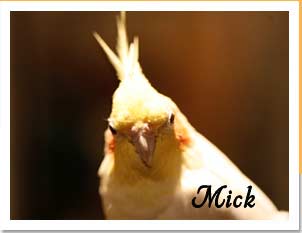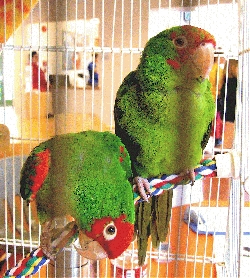JUST IMAGINE....
By Michelle Yesney
 Mickaboo has some very well established principles that are taught in our classes, reiterated when people adopt our birds, and (I hope) pop up in conversations when our volunteers talk to family and friends about keeping companion birds. We forbid breeding and emphasize the importance of feeding a varied diet, for example. We also encourage safe caging, the provision of lots of toys, and interaction between humans and birds. Sunshine is better than artificial light. You all know these things, and so do I. But we had a very moving and kind of surprising experience last year that brought our principles home in a very powerful way.
Mickaboo has some very well established principles that are taught in our classes, reiterated when people adopt our birds, and (I hope) pop up in conversations when our volunteers talk to family and friends about keeping companion birds. We forbid breeding and emphasize the importance of feeding a varied diet, for example. We also encourage safe caging, the provision of lots of toys, and interaction between humans and birds. Sunshine is better than artificial light. You all know these things, and so do I. But we had a very moving and kind of surprising experience last year that brought our principles home in a very powerful way.
Many know about the flock of cockatiels that were surrendered to the Santa Cruz County shelter after we encouraged the owners, retired breeders, to do so. Neighbors of the breeders had talked to our volunteers about the poor conditions the birds were kept in and asked us to help rescue them. We had talked to the shelter staff and promised to take the birds as soon as we could, and to help in the meantime. A total of 19 cockatiels were taken to the shelter, which placed them in a number of cages in a large room at the shelter. Most of the birds appeared to be generally healthy. The five birds that appeared the least healthy were taken to For the Birds in San Jose. Basic tests found that these five birds had varying combinations of giardia, spiral bacteria (sometimes called spirochetes), and avian gastric yeast (AGY).
We knew that trying to medicate 19 cockatiels, most of them not very tame, would be difficult. Dr. Van Sant felt that all of the infections were opportunistic – taking advantage of the birds' weakened conditions resulting from malnutrition and dirty conditions. So I took four of these five birds into my outdoor aviary. It was August, the weather was warm, and my birds only occupied the aviary during the day, anyway. The fifth bird was getting sicker and stayed at the hospital.
So the four tiels started a new life. For several days, they would only climb around the walls and roof of the aviary, and seemed nervous about flying (one had so many broken wing and tail feathers, he could not fly). Eventually they would start to fly short hops. The saddest sight I have seen in a long time was the line-up of all four birds first thing every morning – all facing the rising sun. These birds behaved as though they had never seen the sun...and maybe they had not. Each morning, they would line up to face the sun, soaking it up.
They all ate anything that was put out for them; although they had been fed a seed diet, there was no hint of “conversion” reluctance. They ate Nutrian cakes and raw vegetables as though they had never seen food. The days went by, with the four birds spending their days climbing and flying, playing with toys, and sleeping in the sunshine. One of this four was Marie, the “matriarch” – the female cockatiel first purchased by the breeders and the mother of the larger group. She is a charming lady, and tame. She liked to jump on my head from a platform near the door. She was also the sickest of the four in the aviary, with a very heavy AGY infection.
Three weeks after they came to live with me, Marie tested free of all infections. No medicine, just sunshine, exercise, and healthy food.
Particularly given the severely ill cockatiel still remaining at For the Birds, Dr. Van Sant went to the shelter to test the remaining 14 birds and found the same situation as with the first five – obvious signs of malnutrition and combinations of spirochetes, giardia, and avian gastric yeast. She called Lafeber's and asked if they would donate sufficient Nutrian cakes to the shelter to feed all of the birds as they recovered. They agreed to do so, and sent a substantial quantity of the cakes to the shelter.
While the four birds in my aviary were recovering rapidly, the bird left behind in the hospital died. He literally wasted away, despite eating constantly. The only thing he tested positive for was avian gastric yeast. Cockatiels are generally resistant to AGY, and the severity of this infection was mystifying. Dr. Van Sant reached out to various avian veterinarians and researchers, trying to find a clue. One contact, Dr. Richie in Georgia, remembered an anecdote he had heard recently. In a situation where cockatiels were kept in filthy conditions, exposed to rodent droppings (for example) and malnourished, AGY could intensify to such an extent that the ability of the stomach to produce hydrochloric acid to aid in food digestion was damaged. The bird would starve to death.
With that information, Dr. Van Sant devised a treatment for the next cockatiel from this flock that arrived from Santa Cruz with symptoms of a wasting disease. It worked – the cockatiel recovered.
All of the cockatiels were improving rapidly, and the four in my aviary went off to a new foster home with a clean bill of health. Several of the birds still at the shelter also tested negative and were taken to foster homes. Our Santa Cruz volunteers were making multiple trips to the shelter every day during this same time frame to give these caged birds as much of the good food and sunshine therapy as possible. They chopped vegetables, fed the birds Nutrian cakes, and dragged the cages outside into the sun, day after day.
The last five at the shelter came to live with me for a little while – happy to fly in the sunshine, eat cakes and veggies, and play with toys. The last three of this five were the only ones of those who lived in my aviary that tested positive for anything by the end of that summer – and their AGY was almost gone. So those three received medical treatment (oral meds) for two weeks and we saw the AGY disappear. All of these 18 surviving cockatiels required additional time to recover from the physical effects of advanced malnutrition. We just gave them a running start.
So what I saw last summer was that sunshine, exercise, and healthy food is very good for birds. No surprise. In fact, it is so good for them that it can return them to...if not good health, at least the road to good health in just a few weeks – after a lifetime of living in what must have been hellish conditions.
Just imagine what it would be like if all companion birds had those things – sunshine, exercise, healthy food – for all of their lives....

